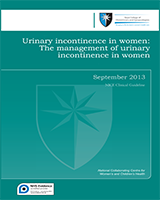| Routine digital assessment of pelvic floor muscle contraction should be undertaken before the use of supervised pelvic floor muscle training for the treatment of UI. [2006] | Undertake routine digital assessment to confirm pelvic floor muscle contraction before the use of supervised pelvic floor muscle training for the treatment of UI. [2006, amended 2013] | Updated to improve clarity and implementation |
| The use of multichannel cystometry, ambulatory urodynamics or videourodynamics is not recommended before starting conservative treatment. [2006] | Do not perform multi-channel cystometry, ambulatory urodynamics or videourodynamics before starting conservative management. [2006, amended 2013] | The urodynamic recommendations have been updated and reordered to improve clarity and implementation |
Multichannel filling and voiding cystometry is recommended in women before surgery for UI if:
there is clinical suspicion of detrusor overactivity, or there has been previous surgery for stress incontinence or anterior compartment prolapse,or there are symptoms suggestive of voiding dysfunction.
Ambulatory urodynamics or videourodynamics may also be considered in these circumstances. | After undertaking a detailed clinical history and examination, perform multichannel filling and voiding cystometry before surgery in women who have:
symptoms of OAB leading to a clinical suspicion of detrusor overactivity, or symptoms suggestive of voiding dysfunction or anterior compartment prolapse, or had previous surgery for stress incontinence. [2006, amended 2013]
| The urodynamic recommendations have been updated and reordered to improve clarity and implementation |
| For the small group of women with a clearly defined clinical diagnosis of pure stress UI, the use of multichannel cystometry is not routinely recommended. [2006] | Do not perform multi-channel filling and voiding cystometry in the small group of women where pure SUI is diagnosed based on a detailed clinical history and examination. [2006, amended 2013] | The urodynamic recommendations have been updated and reordered to improve clarity and implementation |
| In women with UI who also have cognitive impairment, prompted and timed voiding toileting programmes are recommended as strategies for reducing leakage episodes. [2006] | No recommendation | Recommendation removed as this population is now within the remit of another guideline |
| Immediate release non-proprietary oxybutynin should be offered to women with OAB or mixed UI as first-line antimuscarinic drug treatment, if bladder training has been ineffective. If immediate release oxybutynin is not well tolerated, darifenacin, solifenacin, tolterodine, trospium or an extended release or transdermal formulation of oxybutynin should be considered as alternatives. Women should be counselled about the adverse effects of antimuscarinic drugs. [2006] | Offer one of the following choices first to women with OAB or mixed UI:
oxybutynin (immediate release), or tolterodine (immediate release), or darifenacin (once daily preparation). [new 2013]
| Follow the network meta-analysis the recommendation for first line OAB drug treatment have been updated to reflect the current evidence. |
| An early treatment review should be undertaken following any change in antimuscarinic drug therapy. [2006] | Offer a face-to-face or telephone review 4 weeks after the start of each new OAB drug treatment. Ask the woman if she is satisfied with the therapy:
If improvement is optimal, continue treatment. If there is no or suboptimal improvement or intolerable adverse effects change the dose, or try an alternative OAB drug (see recommendations 59 – 60), and review again 4 weeks later. [new 2013]
| The GDG recommended a more structured review schedule to improve care for women under treatment |
| Propiverine should be considered as an option to treat frequency of urination in women with OAB, but is not recommended for the treatment of UI. [2006] | If the first treatment for OAB or mixed UI is not effective or well-tolerated, offer another drug with the lowest acquisition cost.2
[new 2013] | Follow the network meta-analysis the recommendation for first line and second-line options for OAB drug treatment have been updated to reflect the current evidence. |
| Bladder wall injection with botulinum toxin A should be used in the treatment of idiopathic detrusor overactivity only in women who have not responded to conservative treatments and who are willing and able to self-catheterise. Women should be informed about the lack of long-term data. There should be special arrangements for audit or research. The use of botulinum toxin A for this indication is outside the UK marketing authorisation for the product. Informed consent to treatment should be obtained and documented. [2006] | Discuss the risks and benefits of treatment with botulinum toxin A with women before seeking informed consent, covering:
the likelihood of being symptom free or having a large reduction in symptoms the risk of clean intermittent catheterisation and the potential for it to be needed for variable lengths of time after the effect of the injections has worn off the absence of evidence on duration of effect between treatments and the long-term efficacy and risks the risk of adverse effects, including an increased risk of urinary tract infection [new 2013]
| Following the review of BoNT-A, the recommendation was updated to suit current and recommended practice |
| Botulinum toxin B is not recommended for the treatment of women with idiopathic OAB. [2006] | Do not offer botulinum toxin B to women with proven detrusor overactivity. [2013] | Updated to improve clarity and implementation |
| Sacral nerve stimulation is recommended for the treatment of UI due to detrusor overactivity in women who have not responded to conservative treatments. Women should be offered sacral nerve stimulation on the basis of their response to preliminary percutaneous nerve evaluation. Life-long follow-up is recommended. [2006] | Offer percutaneous sacral nerve stimulation to women after MDT review if:
their OAB has not responded to conservative management including OAB drugs, and they are unable to perform clean intermittent catheterisation. [new 2013]
| The health economic evaluation of SNS in comparison with BoNT-A, along with the GDG clinical opinion, led to the recommendation that SNS should be a secondary or alternative procedure to BoNT=A |
| Augmentation cystoplasty for the management of idiopathic detrusor overactivity should be restricted to women who have not responded to conservative treatments and who are willing and able to self-catheterise. Preoperative counselling should include common and serious complications: bowel disturbance, metabolic acidosis, mucus production and/or retention in the bladder, UTI and urinary retention. The small risk of malignancy occurring in the augmented bladder should also be discussed. Life-long follow-up is recommended. [2006] | Restrict augmentation cystoplasty for the management of idiopathic detrusor overactivity to women whose condition has not responded to conservative management and who are willing and able to self-catheterise. Preoperative counselling for the woman or her carer should include common and serious complications: bowel disturbance, metabolic acidosis, mucus production and/or retention in the bladder, UTI and urinary retention. Discuss the small risk of malignancy occurring in the augmented bladder. Provide life-long follow-up [2006, amended 2013] | Updated to improve clarity and implementation |
| Urinary diversion should be considered for a woman with OAB only when conservative treatments have failed, and if sacral nerve stimulation and augmentation cystoplasty are not appropriate or are unacceptable to her. Life-long follow-up is recommended. [2006] | Urinary diversion should be considered for a woman with OAB only when conservative management has failed, and if botulinum toxin A , percutaneous sacral nerve stimulation and augmentation cystoplasty are not appropriate or are unacceptable to her. Provide life-long follow-up. [2006, amended 2013] | Updated to improve clarity and implementation |
| Retropubic mid-urethral tape procedures using a ‘bottom-up’ approach with macroporous (type 1) polypropylene meshes are recommended as treatment options for stress UI if conservative management has failed. Open colposuspension and autologous rectus fascial sling are the recommended alternatives when clinically appropriate. [2006] | If conservative management for SUI has failed, offer:
synthetic mid-urethral tape (see recommendations 1.10.3–8), or
open colposuspension (see also recommendation 1.10.9), or
autologous rectus fascial sling (see also recommendation 1.10.10). [new 2013] | Updated to improve clarity and implementation |
| Synthetic slings using a retropubic ‘top-down’ or a transobturator foramen approach are recommended as alternative treatment options for stress UI if conservative management has failed, provided women are made aware of the lack of long-term outcome data. [2006] | When offering a synthetic mid-urethral tape procedure, surgeons should:
use procedures and devices for which there is current high quality evidence of efficacy and safety only use a device that they have been trained to use (see recommendations in section 1.11) use a device manufactured from type 1 macroporous polypropylene tape consider using a tape coloured for high visibility, for ease of insertion and revision. [new 2013]
| Following the review of mid-uretheral tapes this recommendation was replaced to reflect the current evidence and requirement for a more detailed instruction. |
| Synthetic slings using materials other than polypropylene that are not of a macroporous (type 1) construction are not recommended for the treatment of stress UI. [2006] | When offering a synthetic mid-urethral tape procedure, surgeons should:
use procedures and devices for which there is current high quality evidence of efficacy and safety only use a device that they have been trained to use (see recommendations in section 1.11) use a device manufactured from type 1 macroporous polypropylene tape consider using a tape coloured for high visibility, for ease of insertion and revision. [new 2013]
| Following the review of mid-uretheral tapes this recommendation was replaced to reflect the current evidence and requirement for a more detailed instruction. |
Intramural bulking agents (glutaraldehyde cross-linked collagen, silicone, carbon-coated zirconium beads or hyaluronic acid/dextran copolymer) should be considered for the management of stress UI if conservative management has failed. Women should be made aware that:
repeat injections may be required to achieve efficacy efficacy diminishes with time efficacy is inferior to that of retropubic suspension or sling. [2006]
| Consider intramural bulking agents (silicone, carbon-coated zirconium beads or hyaluronic acid/dextran copolymer) for the management of stress UI if conservative management has failed. Women should be made aware that:
repeat injections may be needed to achieve efficacy efficacy diminishes with time efficacy is inferior to that of synthetic tapes or autologous rectus fascial slings.. [2006, amended 2013]
| Collagen has been removed from current practice, and this recommendation has been updated to reflected this. |


